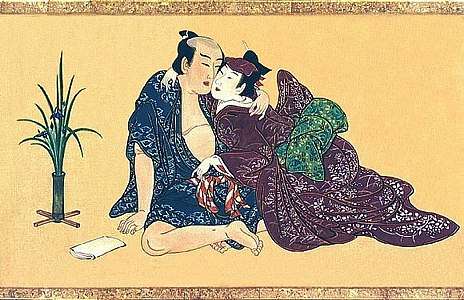Miyagawa Isshō
Miyagawa Isshō (宮川 一笑, 1689 – 20 January 1780) was a Japanese painter in the ukiyo-e style, primarily depicting kabuki actors, geisha, sumo wrestlers, and other elements of everyday urban culture. He used several other names: Fujiwara Andō (藤原 安道), Kohensai (湖辺斎) and other; his common name was Kiheiji (喜平治).[1]
Miyagawa Isshō | |
|---|---|
宮川 一笑 | |
| Born | 1689 |
| Died | January 20, 1780 |
| Style | ukiyo-e |
The majority of Isshō's works that survive come from the Kyōhō era (1716–1736). He was a pupil of Miyagawa Chōshun (1682–1752),[2] who, in turn, was influenced by the works of Hishikawa Moronobu. Like many ukiyo-e artists, Isshō also produced a number of shunga, paintings of erotic scenes.
Isshō was banished from Edo in 1751, along with his master Chōshun, to the island of Niijima off the Izu Peninsula for a year.[1] This came after a dispute arose over the payment for a painting commission in Nikkō. A Kanō school artist commissioned Chōshun to paint some of the walls of the Nikkō Tōshō-gū but refused or was unable to pay. In the ensuing confrontation, the Kanō artist and two others were killed by Isshō and Chōshun's son[2] Isshō was never pardoned and died on 20 January 1780.[2][1]
 Miyagawa Isshō painting. Untitled.
Miyagawa Isshō painting. Untitled. From the Spring Pastimes series.
From the Spring Pastimes series. From the Spring Pastimes series.
From the Spring Pastimes series.
See also

References
Works cited
- Japan Ukiyo-e Association (1982). Genshoku Ukiyo-e Dai-Hyakka Jiten 原色 浮世絵大百科事典 第6巻 [Original Colour Grand Ukiyo-e Encyclopaedia]. 6. Taishūkan Publishing.CS1 maint: ref=harv (link)
- "Miyagawa Issho (宮川一笑) (Biographical details)". British Museum. Retrieved 7 June 2018.